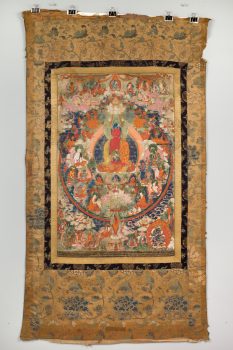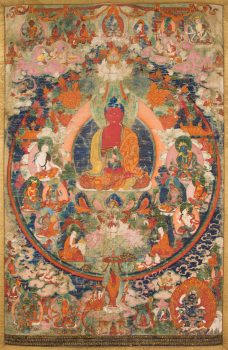Central Tibet
late 18th century



Central Tibet
late 18th century



Buddha Amitabha, known as the Buddha of Immeasurable Light, is popular among all Tibetan Buddhist traditions. He is said to reside in his Realm of Great Bliss (Sukhavati), a desired realm of higher existence. Depicted in red and wearing the traditional patchwork robes of a monk, he sits in the lotus position with his hands in a meditative gesture (dhyana mudra) holding a bowl of nectar. Here he is shown within a palace, accompanied by the Eight Great Bodhisattvas. Illustrating the wishes of practitioners and devotees, a scene at the lower center shows him receiving people entering his pure realm on a beam of rainbow light.
In Buddhism merit is accumulated through engaging in positive actions that lead to positive results, such as better rebirths. Buddhists gain merit by making offerings, donating to those in need, reciting mantras, and other good deeds.
Prescribed practices that carry symbolic meaning and value within a specific tradition and are intended to attain a desired outcome. Rituals are usually done as part of a ceremony or regular routine.
An awakened being who understands the true nature of reality and is free from the cycle of birth, death, and rebirth. While there are many buddhas, Siddhartha Gautama is the historical Buddha, whose teachings became the foundation of Buddhism.
Today, Tibetans primarily inhabit the Tibetan Plateau, situated between the Himalayan mountain range and the Indian subcontinent to the west, Chinese cultural regions to the east, and Mongolian cultural regions to the northeast. During the 7th to 9th century, Tibetan rulers expanded their empire across Central Asia, and established Buddhism as the state religion.
Get the latest news and stories from the Rubin, plus occasional information on how to support our work.